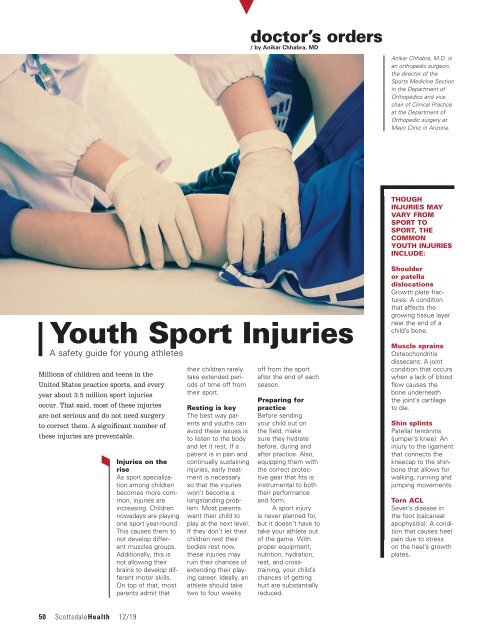Scottsdale Health December 2019
Create successful ePaper yourself
Turn your PDF publications into a flip-book with our unique Google optimized e-Paper software.
doctor’s orders<br />
/ by Anikar Chhabra, MD<br />
Anikar Chhabra, M.D. is<br />
an orthopedic surgeon,<br />
the director of the<br />
Sports Medicine Section<br />
in the Department of<br />
Orthopedics and vice<br />
chair of Clinical Practice<br />
at the Department of<br />
Orthopedic surgery at<br />
Mayo Clinic in Arizona.<br />
THOUGH<br />
INJURIES MAY<br />
VARY FROM<br />
SPORT TO<br />
SPORT, THE<br />
COMMON<br />
YOUTH INJURIES<br />
INCLUDE:<br />
Youth Sport Injuries<br />
A safety guide for young athletes<br />
Millions of children and teens in the<br />
United States practice sports, and every<br />
year about 3.5 million sport injuries<br />
occur. That said, most of these injuries<br />
are not serious and do not need surgery<br />
to correct them. A significant number of<br />
these injuries are preventable.<br />
Injuries on the<br />
rise<br />
As sport specialization<br />
among children<br />
becomes more common,<br />
injuries are<br />
increasing. Children<br />
nowadays are playing<br />
one sport year-round.<br />
This causes them to<br />
not develop different<br />
muscles groups.<br />
Additionally, this is<br />
not allowing their<br />
brains to develop different<br />
motor skills.<br />
On top of that, most<br />
parents admit that<br />
their children rarely<br />
take extended periods<br />
of time off from<br />
their sport.<br />
Resting is key<br />
The best way parents<br />
and youths can<br />
avoid these issues is<br />
to listen to the body<br />
and let it rest. If a<br />
patient is in pain and<br />
continually sustaining<br />
injuries, early treatment<br />
is necessary<br />
so that the injuries<br />
won’t become a<br />
longstanding problem.<br />
Most parents<br />
want their child to<br />
play at the next level.<br />
If they don’t let their<br />
children rest their<br />
bodies rest now,<br />
these injuries may<br />
ruin their chances of<br />
extending their playing<br />
career. Ideally, an<br />
athlete should take<br />
two to four weeks<br />
off from the sport<br />
after the end of each<br />
season.<br />
Preparing for<br />
practice<br />
Before sending<br />
your child out on<br />
the field, make<br />
sure they hydrate<br />
before, during and<br />
after practice. Also,<br />
equipping them with<br />
the correct protective<br />
gear that fits is<br />
instrumental to both<br />
their performance<br />
and form.<br />
A sport injury<br />
is never planned for,<br />
but it doesn’t have to<br />
take your athlete out<br />
of the game. With<br />
proper equipment,<br />
nutrition, hydration,<br />
rest, and crosstraining,<br />
your child’s<br />
chances of getting<br />
hurt are substantially<br />
reduced.<br />
Shoulder<br />
or patella<br />
dislocations<br />
Growth plate fractures:<br />
A condition<br />
that affects the<br />
growing tissue layer<br />
near the end of a<br />
child’s bone.<br />
Muscle sprains<br />
Osteochondritis<br />
dissecans: A joint<br />
condition that occurs<br />
when a lack of blood<br />
flow causes the<br />
bone underneath<br />
the joint’s cartilage<br />
to die.<br />
Shin splints<br />
Patellar tendinitis<br />
(jumper’s knee): An<br />
injury to the ligament<br />
that connects the<br />
kneecap to the shinbone<br />
that allows for<br />
walking, running and<br />
jumping movements.<br />
Torn ACL<br />
Sever’s disease in<br />
the foot (calcaneal<br />
apophysitis): A condition<br />
that causes heel<br />
pain due to stress<br />
on the heel’s growth<br />
plates.<br />
50 <strong>Scottsdale</strong><strong>Health</strong> 12/19

















